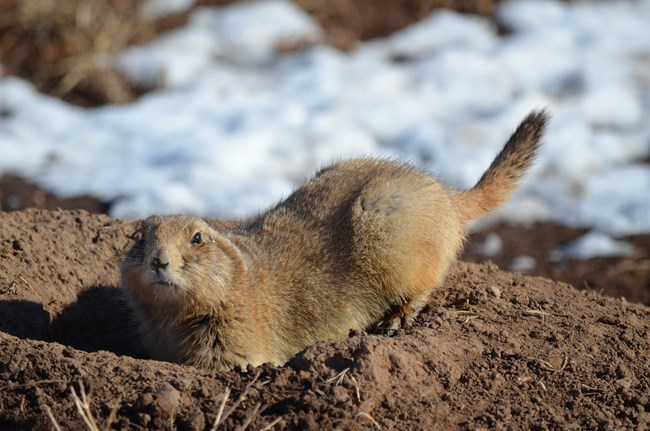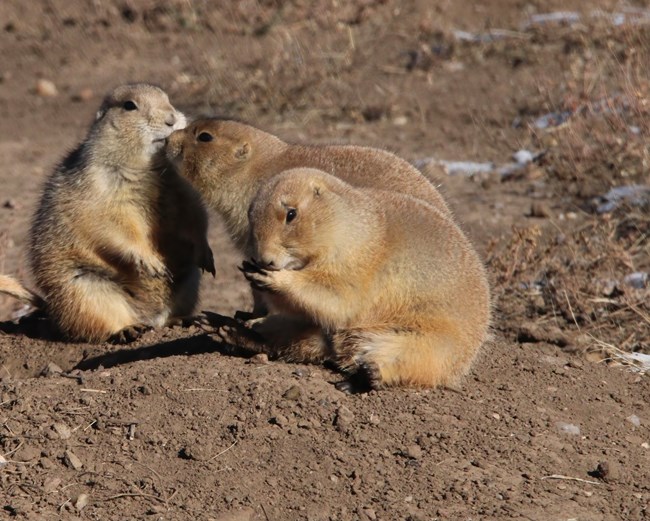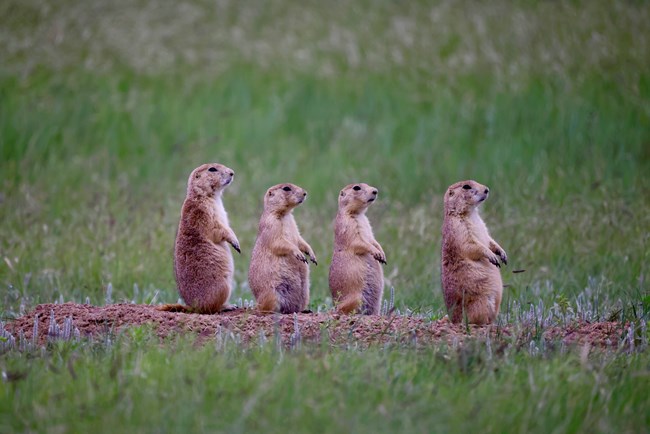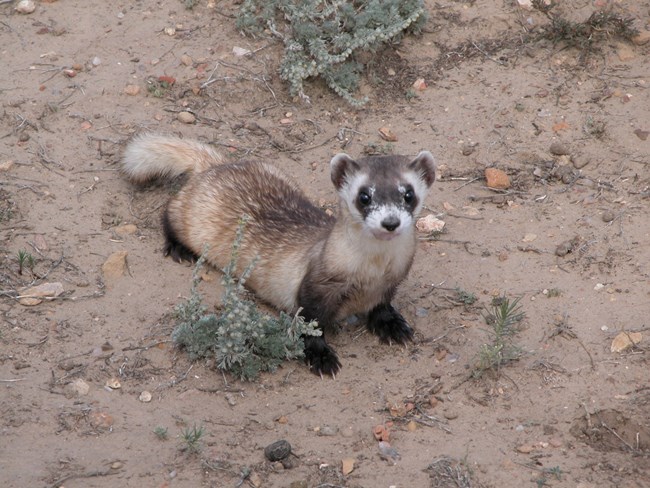
NPS photo 
NPS Photo The prairie dog, a rodent that belongs to the squirrel family, is perhaps the most easily viewed animal in the park. They get their name from their bark-like call, first described as “petit chien”, or “little dog”, by French explorers. There are five species of prairie dog in North America, one of which lives in the park: the black-tailed prairie dog, named for the black tip of its tail. All prairie dogs have small ears, short tails, and muscular legs. Their fur is tan in color and often blends in with the earth in which they dig their burrows, helping camouflage them. 
NPS Photo / Peelee Clark Prairie dogs rely on keen hearing, excellent eyesight and a communal warning system for protection against predators. They are social, living together in areas called towns. A prairie dog town is much like one of our own, with the animals digging their burrows next to each other, socializing, and sharing protection duties. Towns now vary in size from one acre to several hundred, but may have stretched for miles prior to European arrival. Some of the largest prairie dog towns are located in South Dakota. Towns contain smaller neighborhoods of prairie dogs, called coteries. A typical coterie consists of one male, three to four females, and juveniles up to one year old. The residents of each coterie protect their territory from intruders, sometimes including members of other coteries in the town. Prairie dog social structure and behavior is unique. Members of the coteries cooperate with each other, rarely competing for food and shelter, and occupying functionally equal social positions. Neighbors recognize each other with a kiss. They may also be seen grooming each other, cooperating in defense and the construction of burrows, eating and playing together, or simply standing side by side on a mound of earth. Communication between the members of a town is important and highly specialized. Over ten different calls have been described, including sounds for warning, defense, territoriality, fear, and fighting. Different predators, such as rattlesnakes and coyotes, may warrant unique calls. A warning cry from one prairie dog sends all within earshot hustling for their burrows. Prairie dog burrows have not been studied intensively, but some general features are known. Depth of the burrow system is often governed by the local soils. In deep soil, the burrows may extend downward for ten or more feet, averaging 24 feet of tunnel per entrance. The prairie dogs pack a conical mound of soil around the entrance of the main burrow to serve as a lookout post and as protection against flooding. The entrance tunnel section extends steeply downward for several feet with the next tunnel section being gently inclined, descending down to the nest. The nest chamber is usually lined with grasses. Some tunnels then return to the surface, often with a depressed, crater-like opening marking their terminus. Several burrows may be connected underground. Tunnel plugs are common, but may be quickly re-excavated in emergencies. 
NPS photo / Peelee Clark Prairie dogs only give birth to one litter per year. The breeding season occurs in March and April, with the young being born 4 to 5 weeks later. The size of the litter varies from 2 to 8 young, nursed by the mother for about 6 weeks. From May to early June, the young begin to emerge from their burrows. At this time, yearlings and some adults may relocate, leaving the young pups secure in the old burrow. When prairie dogs relocate, most take over abandoned holes or dig new ones at the edge of the town. Black-tailed prairie dogs have incomplete hibernation, with their activity and appetite decreasing during the winter. They may sleep for days at a time, but the town is usually active during the milder days of the winter. 
BLM Photo Prairie dogs are arguably the prairie’s most important animal. They are known as a keystone species. This means that everything is connected to them in some way, and little could survive without them around. First, they are critical players in keeping the prairie healthy. Their grazing helps grasses regenerate, they and other animals drawn to the towns aid in fertilizing the prairie and distributing seeds, and pollinators critical to prairie plants may rely on other aspects of the towns. Naturally, some animals also prey on the dogs. Common predators of the prairie dog include coyotes, bobcats, eagles, hawks, and badgers. For many of those, prairie dogs are their primary food source within the park. One predator, the black-footed ferret, deserves special mention. Considered by many to be North America’s most endangered mammal, about 90% of the ferret’s diet consists of black-tailed prairie dogs. They also make their homes in the prairie dogs’ burrows. Widespread poisoning and fragmentation of dog towns endangered this special mammal. Other animals rely on different aspects of prairie dog towns. Creatures such as snakes, owls, and spiders are fond of using abandoned burrows as homes. Bison have a long-standing mutualistic relationship with prairie dogs-- they graze at the towns, helping prairie dogs spot predators through the shorter grass. In return, the bison get to roll in the dust stirred up by the dogs’ digging, giving them the ability to dislodge pests and scratch off their thicker winter coats. Prairie dogs have one major threat even in areas where they are protected from poisoning and poaching, and that is disease. They are vulnerable to many canine diseases, as well as the sylvatic plague, carried by fleas. It is important to keep these keystone animals healthy, so park researchers are currently testing different flea treatments for the prairie dogs. These treatments are no different from ones you might choose for your dog or cat. Prairie dogs are fascinating, charismatic, and important animals. Enjoy watching them during your visit to the park-- just make sure to give them space and keep your food away from them. View Wind Cave National Park's prairie dog management plan.
|
Last updated: October 31, 2023
